Research
Supply chain of the green hydrogen energy technology is divided into three major blocks: 1. Hydrogen generation, 2. Hydrogen storage, 3. Hydrogen application. Among them, hydrogen generation- Anion Exchange Membrane Water Splitting is the most lacking, and there are almost no large-scale products available in the market. Next, in the field of hydrogen storage, we can cooperate with large domestic gas suppliers, but small-scale or non-gaseous phase hydrogen storage still need research. The application of hydrogen is the most mature field in downstream of the industrial chain, such as fuel cells, mixed combustion power, etc., and commercial products are already available. The other direction is to convert CO2, which is to use hydrogen to react with CO2 to convert it into chemicals, thereby consuming CO2 in the atmosphere, but it still requires more advanced and a large amount of research and development energy investment, so that the generated compounds have higher value-added or enhance product purity. Therefore, a whole team is required to complete the integration of the upstream and downstream of supply chains in order to effectively promote the hydrogen energy economy and achieve the goal of negative carbon emissions.
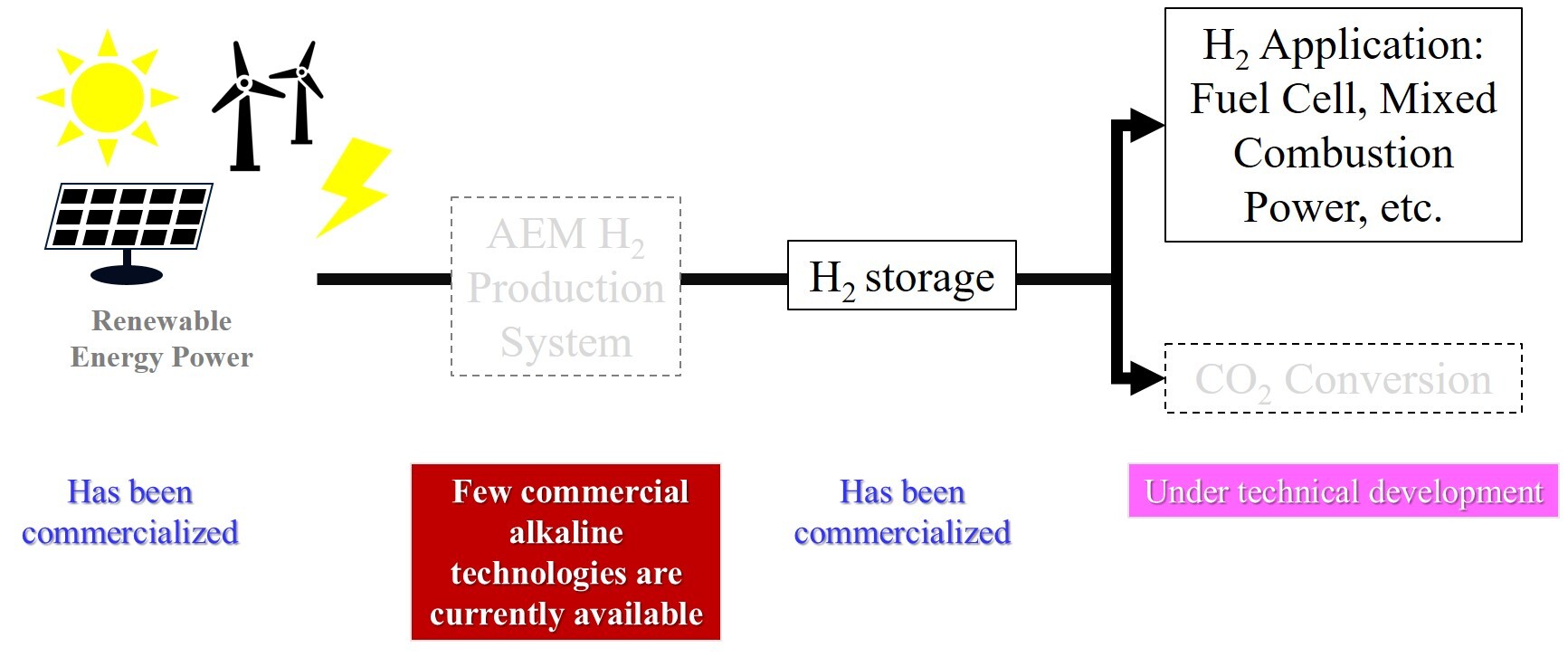
Nowadays, hydrogen production of anion-exchange membrane water electrolyser (AEMWE) is immature, and the cost of noble metal catalysts and electricity is high. Therefore, catalysts with low-cost, high efficiency and strong durability are needed to make production of green hydrogen commercialized. The Acid Redox-assisted Deposition (ARD) created by Prof. Chen group, use redox reactions to deposit variety of transition metals on any type of substrate at atmosphere to form a continuous and dense multi-metal oxide film catalyst. The results of this catalyst shows that the effect of electrolyzed is equivalent to noble metal catalyst, effectively reducing the cost of the catalyst to less than thousandth. Finally, the catalyst was successfully trial-produced by the roll-to-roll process.

In addition, the excellent adhesion of the catalyst overcomes the common bottleneck under high current operation - the catalyst is easily peeled off from the electrode. The team's technology can reach a stable operation under the condition of 5 A/cm2
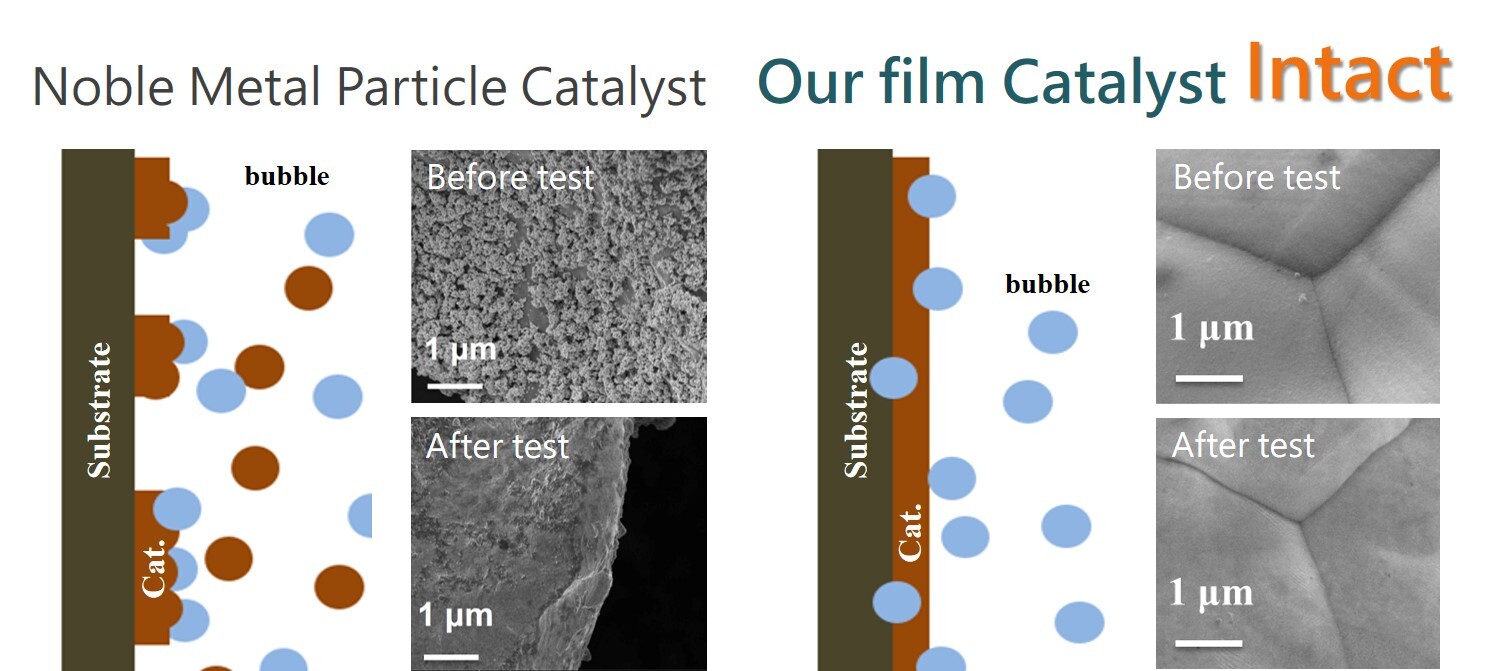
We Preliminary proof that the dense complex oxides catalyst can prevent the corrosion of ClO- ions, and in addition to completely covering the electrode surface, it also prevents the electrode from reacting with ClO-. This result shows that Taiwan's huge seawater energy can be effectively used as a feasibility and storage technology for the development of green hydrogen in the future.
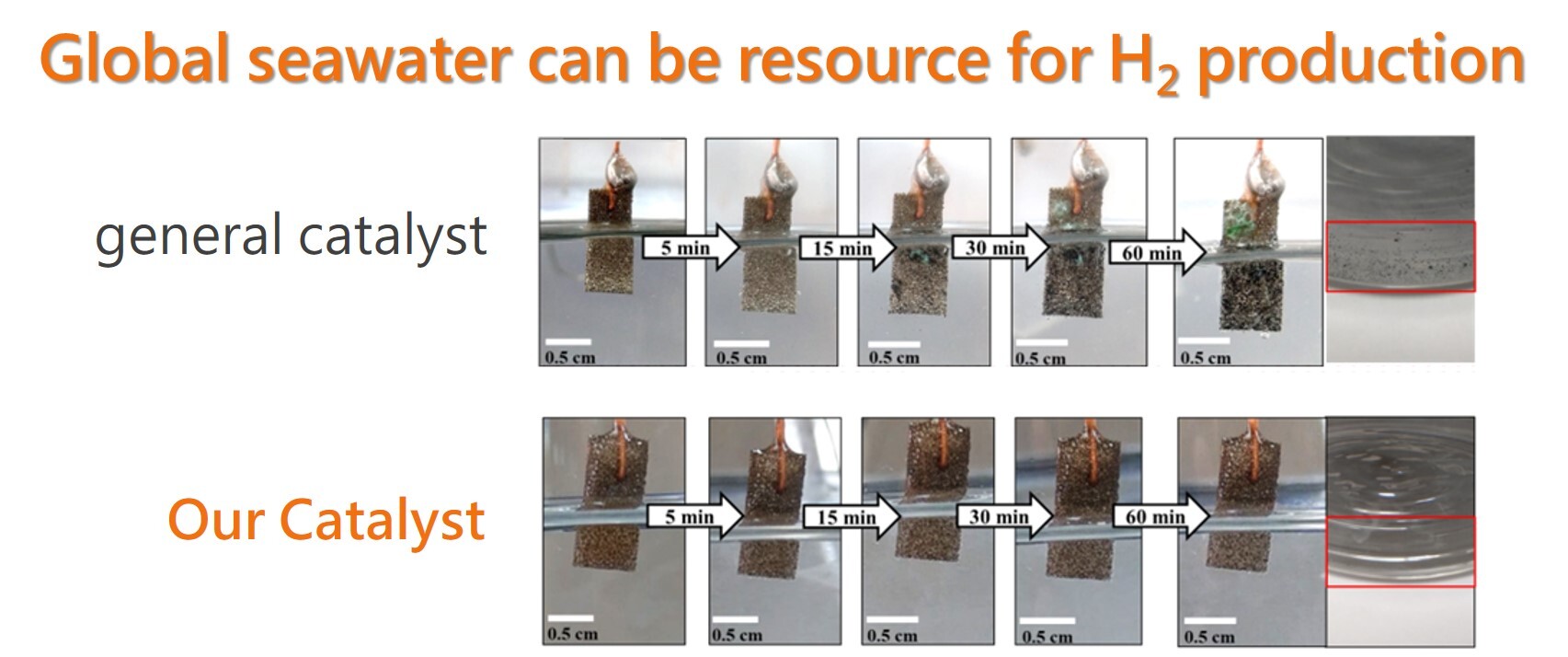
Reference:
- T.-A. Zegeye; W.-T. Chen; C.-C. Hsu; J. A. A. Valinton; C.-H. Chen* Activation Energy Assessing Potential-Dependent Activities and Site Reconstruction for Oxygen Evolution. ACS Energy Lett. 2022, 7, 2236-2243.
- C.-H. Yeh; W.-Y. Hsu; C.-C. Hsu; J. A. A.Valinton; C.-I. Yang; C.-C. Chiu*; C.-H. Chen* Cobalt Iron Oxides Prepared by Acidic Redox-Assisted Precipitation: Characterization, Applications, and New Opportunities. ACS Appl. Mater. Interfaces 2021, 13, 52181-52192.
- P.-C. Liao; R.-H. Jhang; Y.-H. Chiu; J.A.A. Valinton; C.-H. Yeh; Jr. V. D. Ebajo; C.-H. Wang; C.-H. Chen* Rock Salt Oxide Hollow Spheres Achieving Durable Performance in Bifunctional Oxygen Energy Cells. ACS Appl. Energy Mater. 2021, 4, 3448-3459.
- M.-C. Shih; R.-H. Jhang; Y.-T. Tsai; C.-W. Huang; Y.-J. Hung; M.-Y. Liao; J. Huang*; C.-H. Chen* Discontinuity-enhanced Thin Film Electrocatalytic Oxygen Evolution. Small 2019, 15, 1903363.
- R.-H. Jhang; C.-Y. Yang; M.-C. Shih; J.-Q. Ho; Y.-T. Tsai; C.-H. Chen* Redox-assisted Multicomponent Deposition of Ultrathin Amorphous Metal Oxides on Arbitrary Substrates: Highly Durable Cobalt Manganese Oxyhydroxide for Efficient Oxygen Evolution. J. Mater. Chem. A 2018, 6, 17915-17928.
Patent:
- Method for Depositing Metal Oxide Thin Films in a Liquid-Phase Environment, Invention Patent of the Republic of China, Publication No. I705936, Publication Date October 1, 2020
Cost is the main fatal flaw to the commercialization of negative carbon technologies, the second is high energy consumption, low CO2 conversion rate and low product selectivity.
To solve the cost problem, it is necessary to replace noble metal (gold, silver) catalysts with earth-abundant transition metals. Professor Hao-ming Chen’s team used the earth's high reserves of elemental iron to break through the above dilemma. The Innovative single-atom iron catalyst (Fe3+), the high valence state of this catalyst enables the conversion of CO2 into CO with low energy consumption, and the 90% high conversion rate and selectivity have met commercial demand. This technology was published on Science (Science 2019, 364, 1091-1094.), and reported by many media.
In order to more understand the key factors for the conversion of CO2 into CO, Prof. Hao-Ming Chen’s team also developed "In-situ X-ray absorption spectroscopy" to monitor the effect of chemical structure changes on the chemoselectivity of catalysts during the reaction process. In addition to in-depth research on the mechanism of carbon dioxide reduction, at the same time, continuous development to promote the commercial transfer of carbon dioxide reduction technology. This technology has developed a rare real-time observation device in the world, and it is also published on Nature Communications.
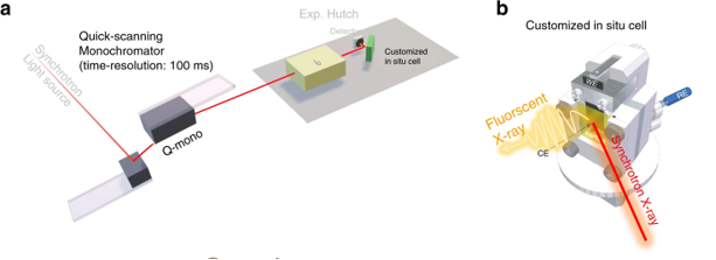
(a) Diagram of the setup for In-situ X-ray absorption spectroscopy (b) The on-site X-ray absorption spectroscopy setup ( Nat. Commun. 2020, 11, 3525.)
Reference:
- H. Sun; C.-W. Tung; Y. Qiu; W. Zhang; Q. Wang; Z. Li; J. Tang; H.-C. Chen; C. Wang*; H.-M. Chen* Atomic Metal-support Interaction Enables Reconstruction-free Dual Sites Electrocatalyst. J. Am. Chem. Soc. 2022, 144, 1174-1186.
- X. Cao; A. Huang; C. Liang; H.-C. Chen; T. Han; R. Lin; Q. Peng;* Z. Zhuang; R. Shen; H.-M. Chen; Y. Yu; C. Chen;* Y. Li* Engineering Lattice Disorder on a Photocatalyst: Photochromic BiOBr Nanosheets Enhance Activation of Aromatic C−H Bonds via Water Oxidation. J. Am. Chem. Soc. 2022, 144, 3386-3397.
- L. Ba; C.-S. Hsu; D. T.L. Alexander; H. M. Chen*; X. Hu* Double-Atom Catalysts Provide a Molecular Platform for Heterogeneous Oxygen Evolution Electrocatalysis. Nat. Energy 2021, 6, 1054-1066.
- S.-C. Lin; C.-C. Chang; S.-Y. Chiu; H.-T. Pai; T.-Y. Liao; C.-S. Hsu; W.-H. Chiang; M.-K. Tsai*; H.-M. Chen* Operando Time-resolved X-ray Absorption Spectroscopy to Unravel the Chemical Nature Enabling Highly Selective CO2 Reduction. Nat. Commun. 2020, 11, 3525.
- J. Deng; S.-C. Lin; J. F. III; J. A. Iñiguez; D. Xiang,; D. Yang; G. Chan; H.-M. Chen*; A. N. Alexandrova*; C. Liu* Ambient Methane Functionalization Initiated by Electrochemical Oxidation of a Vanadium (V)-Oxo Dimer. Nat. Commun. 2020, 11, 3686.
- J. Gu; C.-S. Hsu; L. Bai; H.-M. Chen*; X. Hu* Atomically Dispersed Fe3+ Sites Catalyze Efficient CO2 Electroreduction to CO. Science 2019, 364, 1091.
- B. Weng; K.-Q. Lu; Z. Tang; H.-M. Chen*; Y.-J. Xu* Stabilizing Ultrasmall Au Clusters for Enhanced Photoredox Catalysis. Nat. Commun. 2018, 9, 1543.
Patent:
- Membrane electrode group and electrolytic hydrogen production method, invention patent of the Republic of China, announcement number TW 202242199 A, announcement date: April 21, 2022
- Carbon dioxide electrolysis device, new patent of the Republic of China, announcement number TW M629398 U, announcement date: July 11, 2022
- Carbon dioxide electrolysis device, new patent of the People's Republic of China, announcement number CN 216947223 U, announcement date: July 12, 2022
Computational chemistry methods often used to explore possible hydrogen storage materials
Problem:
- Quantum Chemical calculations deliver adsorption energies. Data hard to interpret.(Is H2 molecules adsorbed or desorbed at a given temperature T and pressure P?)
- Adsorption energies need to be converted into macroscopic observables like coverage rates
Current Approaches :
- Langmuir-Isotherm (and similar analytical models):Only works for very simple systems🡪 Analytical models hard to derive for realistic systems
- Molecular Dynamics (MD) Simulations: Calculates how atoms in a system move as time proceeds;Computationally very demanding, simulated time scales very small compared to “real world” application
Dr. Cheng-Chau Chiu's research can solve the above problems “Kinetic Monte Carlo (kMC)”
Kinetic Monte Carlo (kMC): Numerical method based on the random selection and execution of reactions to simulate evolution of a system
How Does the kMC Approach Work?
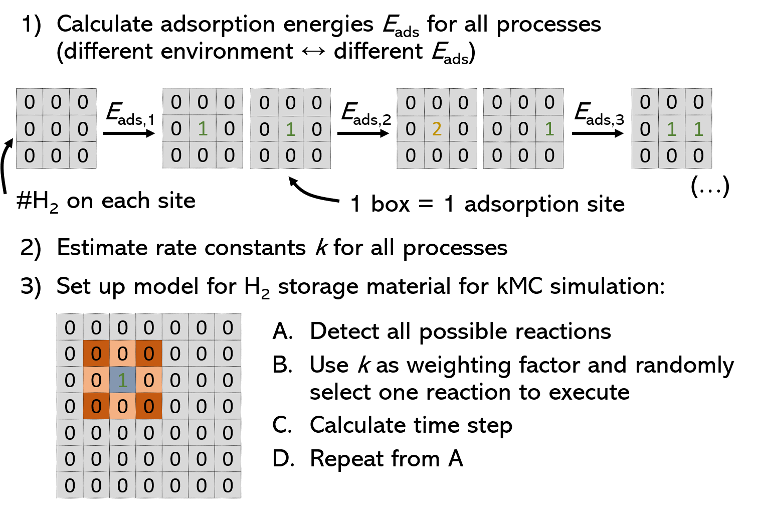
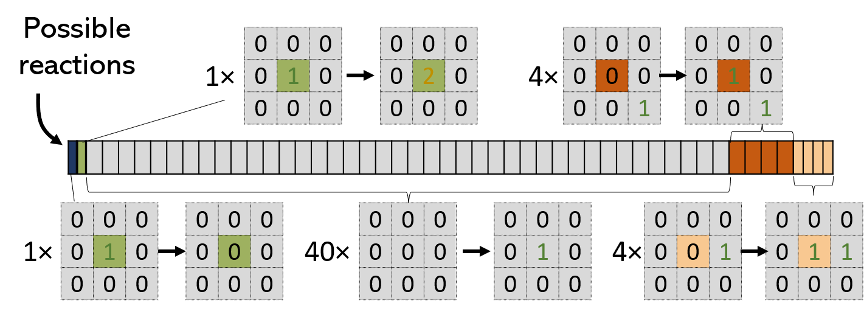
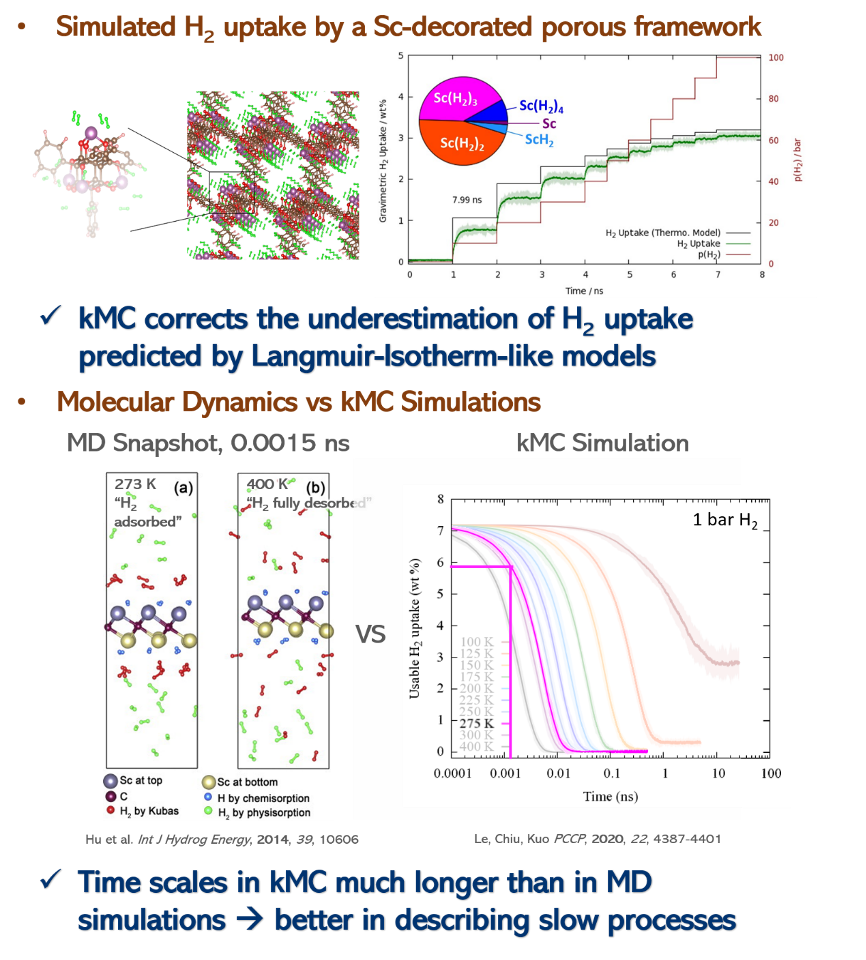
Publications:
- T.N.-M. Le; C.-C. Chiu*; J.-L. Kuo* A decomposition mechanism for Mn2(DSBDC) metal-organic framework in the presence of water molecules. Phys. Chem. Chem. Phys. 2021, 23, 22794-22803.
- T. N.-M. Le; C.-C. Chiu*; J.-L. Kuo* From the perspectives of DFT calculations, thermodynamic modeling, and kinetic Monte Carlo simulations: the interaction between hydrogen and Sc2C monolayers. Phys. Chem. Chem. Phys. 2020, 22, 4387-4401.
Computational chemistry methods often used to explore possible hydrogen storage materials.
Various traditional and emerging pollutants cause the rapid increase of carbon and nitrogen concentrations in water, posing threats to ecology and the environment, such as excessive fertilizers, various sewage discharges, and excessive nutrients released resulting in eutrophication. The relevant regulations are becoming more and more harsh, such as discharge standards, and there is an urgent need for management strategies with high efficiency and low energy consumption.
Generally, carbon removal in water treatment often relies on aerobic biotechnology. The energy consumption required for aeration and the large amount of sludge generated during the reaction process are problems to be solved in the future. In addition, denitrification mostly uses dissolved oxygen in water to oxidize ammonia nitrogen into nitrate nitrogen, and then removes nitrate nitrogen with anaerobic denitrification, and there are still doubts about energy consumption and sludge.
The Anaerobic Ammonium Oxidation (ANAMMOX) method is an anaerobic treatment, although it can reduce the cost of aeration electricity, and the biochemical reaction of self-supporting bacteria does not need to add carbon sources, but have some challenges for systems are not easy to start, and the doubling period is long (about 11-14 days ).
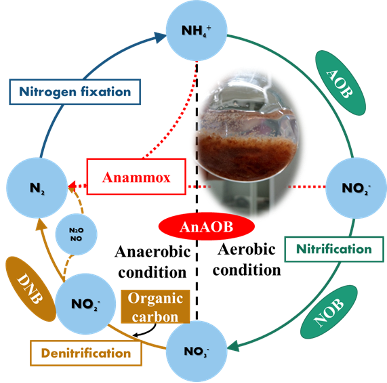
Prof. Wei-Hsiang Chen’s team uses the ANAMMOX of CO2 as the basis, and cooperates with different bacterial groups such as ammonia oxidizing bacteria (AOB), nitrite oxidizing bacteria (NOB), or denitrifying bacteria (DNB) to combine a variety of composite biological treatment systems, and then through Graphene and metal oxide composite materials that have high specific surface area, good electrical conductivity, and rapid catalytic reaction, which can accelerate the domestication of ANAMMOX, quickly start and improve the performance of the composite biological treatment system.
Technical goals::
- The quality of the discharged water meets the requirements of the new regulations and the sustainable recycling of water resources.
- Improve water treatment energy self-sufficiency, towards the goal of zero energy consumption.
- Establish new generation water treatment of green low-carbon technology.
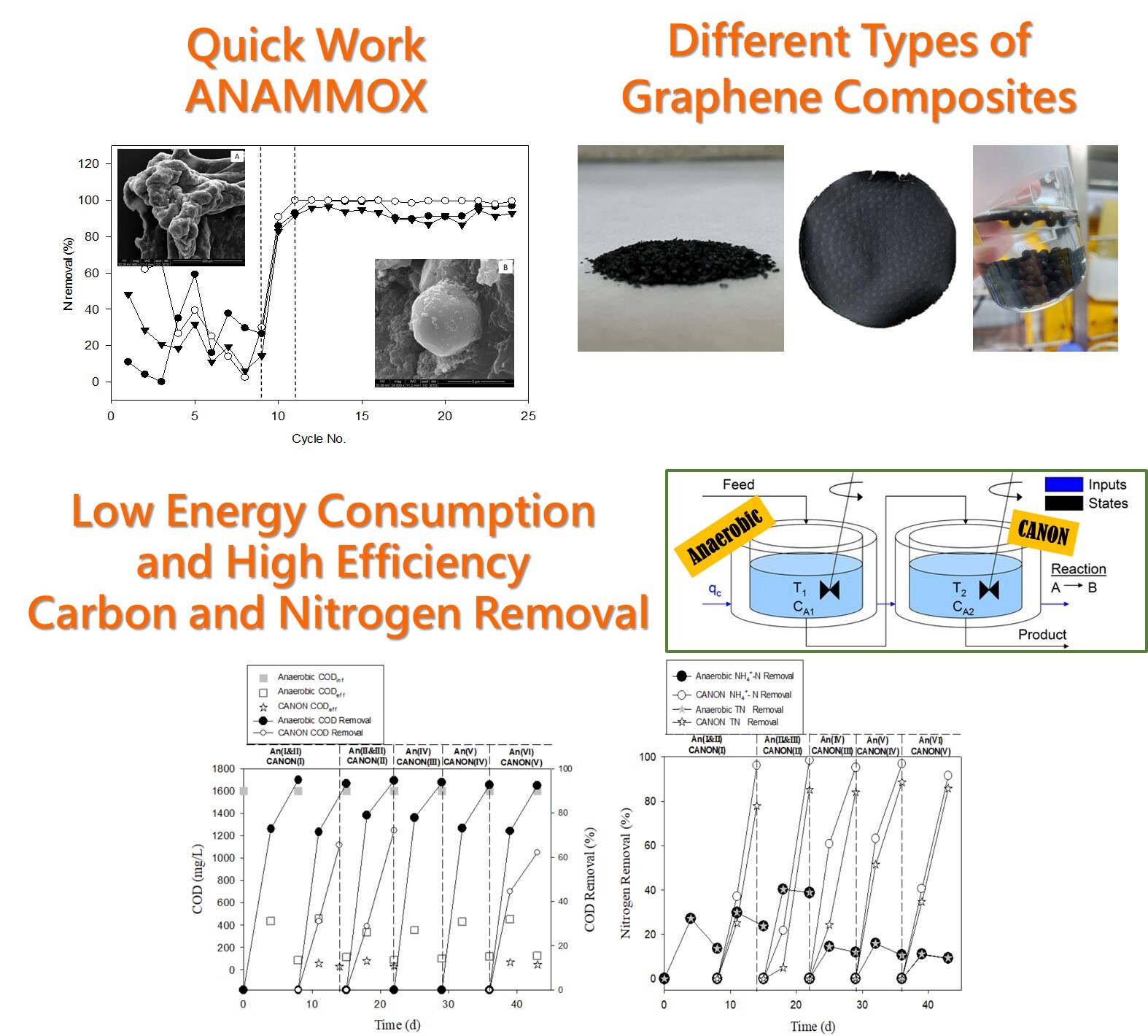
Reference:
- T.-H. Huang; F.-T. Tung; G.-F. Chen; W.-H. Chen* Variations of N concentrations and microbial community in the start-up of anammox using anaerobic heterotrophic sludge: Influence of a long reaction-phase time and comparison of the efficiencies of attached- versus suspended-growth cultures. Chemosphere, 2022, 287, 132151.
- C.-H. Lin; W.-H. Chen* Influence of water, H2O2, H2SO4, and NaOH filtration on the surface characteristics of a graphene oxide-iron (GO-Fe) membrane. Sep. Purif. Technol. 2021, 262, 118317.
- W.-H. Chen*; C.-J. Huang; C.-H. Lin; C.-P. Huang Catalytic degradation of chlorpheniramine over GO-Fe3O4 in the presence of H2O2 in water: The synergistic effect of adsorption. Sci. Total Environ. 2020, 736, 139468.
Patent:
- Graphene oxide-iron composite film, its preparation method and its use, invention patent of the Republic of China, announcement number I743678, announcement date October 21, 2021
- Manufacturing method of iron-containing graphene oxide composite, invention patent of the Republic of China, announcement number I651127, announcement date February 21, 2019
Prof. Wen-Yao Huang and Prof. Mei-Ying Chang have devoted themselves to the design and development of Sulfonated Aromatic Hydrocarbon Polymers for many years. This polymer membrane can be widely used in many industries, such as chlor-alkali industry, vanadium redox flow battery, hydrogen fuel cell, hydrogen purification , Acidic water splitting system, etc.
A series of novel Sulfonated Aromatic Hydrocarbon Polymers have been developed through the rigid structure of the polymer main chain, which not only makes it have good mechanical strength and thermal stability. In addition, the introduction of fluorine groups helps the molecular membrane to have lower dielectric, lower water absorption characteristics, better solubility and higher fire resistance. And compared with the commercially available Nafion 212, it has high IEC value, high proton conductivity, low cost and environmentally friendly manufacturing process in the test. All of the above results have been published in journals and applied for a number of patents.

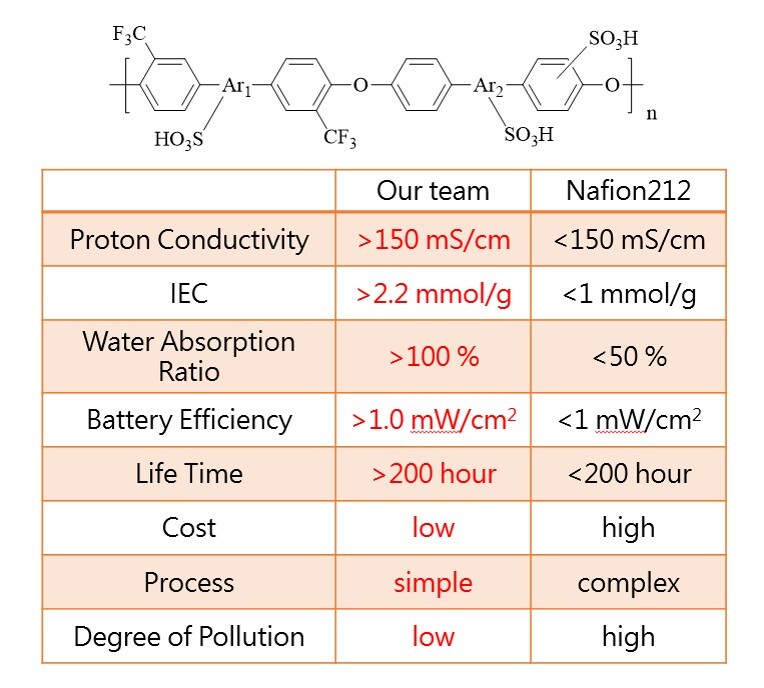
Reference:
- H.-Y. Wen; T.-S. Huang; H.-D. Zhang; M.-Y. Chang; W.-Y. Huang Discrete Conjugated Poly(arylene ether) Compounds for Blue Emission Electroluminescent Devices. ACS Appl. Polym. Mater. 2019, 1, 3343-3353.
Patent:
- Composite material of sulfonated polyaryl ether polymer, new patent of the Republic of China, announcement number M631697, announcement date: September 11, 2022
- Composite material of sulfonated polyaryl ether polymer, invention patent of the People's Republic of China, announcement number CN 114316321 A, announcement date: April 12, 2022
- Cationic conductive polymer, Japanese invention patent, special request 2018-174263 announcement date: May 18, 2020
- Cationic conductive polymer, invention patent of the Republic of China, announcement number I675864, announcement date: November 1, 2019
In the synthesis of more valuable molecular drug derivatives and their functionalization, organolithium reagents are often used for "hydrogen extraction",and the formed anionic nucleophile will open the ABB ring, and finally form a new carbon-carbon bond or carbon-heteroatom bonds. This reagent limits the choice of derivative functional groups and is expensive, unavailable, and environmentally unfriendly.
Therefore, the team of Professor Hsuan-Hung Liao modified the starting material into a "pre-anionic nucleophilic group", and activated the reagent by an "electrocatalytic"method, and used CO2 as the C1 site to synthesize drug molecule derivatives. This method can replace organolithium reagents, and CO2 can be used as a regeneration material under milder reaction conditions.
Professor Chia-Hsiang Chen's team aimed at the problem that most molecular catalysts still require a large amount of energy to drive the electrocatalytic reduction of CO2.Therefore, the development of carbon materials with special structures can reduce CO2 at the lowest feasible overpotential by nitrogen doping nanographene compounds.
Professor Chia-Hsiang Chen used the "bottom to top" synthesis method to change the resonance system of graphene nanometers to adjust the reduction potential of molecular catalysts. Using this material as a ligand in transition metal complexes, a new type of heterogeneous , synthesize a novel heteroatom-doped graphene nano-transition metal catalyst.
This catalyst can selectively convert CO2 into CO with a low catalytic potential. In addition, it can also absorb light of specific wavelengths through graphene nanometers. It is expected that the photocatalytic CO2 reduction reaction can be driven by solar energy. Significantly advance in the direction of green energy and sustainable carbon reduction.

Schematic diagram of the cyclodehydrogenation process of twisted nitrogen-doped graphene nanometers.(Chem. Asian J. 2022, 17, e202200114.)
Reference:
- E.-V. Varghese; C.-F. Gao; Y.-L. Chang; H.-Y. Chen*; C.-H. Chen* Synthesis of Distorted Nitrogen-Doped Nanographenes by Partially Oxidative Cyclodehydrogenation Reaction. Chem. Asian J. 2022, 17, e202200114.
- C.-H. Chen*; L. Spree; E. Koutsouflakis; D.-S. Krylov; F. Liu; A. Brandenburg;G. Velkos; S. Schimmel; S.-M. Avdoshenko; A. Fedorov; E. Weschke;F. Choueikani; P. Ohresser; J. Dreiser; B. Büchner; A.-A. Popov* Magnetic Hysteresis at 10 K in Single Molecule Magnet Self-Assembled on Gold Adv.Sci. 2021, 8, 202000777.
- C.-H. Chen; D.-S. Krylov; S.-M. Avdoshenko; F. Liu.; L. Spree; R. Westerström; C. Bulbucan; M. Studniarek; J. Dreiser; A. U. B. Wolter; B. Büchner; A.-A. Popov* Magnetic Hysteresis in Self-Assembled Monolayers of Dy-Fullerene Single Molecule Magnets on Gold” Nanoscale 2018, 10, 11287-11292.
Increasingly stringent regulations have led to the conversion of fuel for internal combustion engines to hydrogen. Compared with traditional fuels, hydrogen has a wider combustion limit, such as faster flame propagation speed and diffusion speed and other advantages. And can achieve higher efficiency, improved combustion efficiency and fuel economy, while reducing carbon emissions, and thus comply with global zero carbon emission regulations. Instead of using pure hydrogen combustion, the internal combustion engine can be used with only minor modifications and no additional large research and development costs.
Taiwan has a complete engine supply chain. The research and development of hydrogen engine technology can extend the life of the supply chain and production equipment. Most of the materials used in engines are recyclable aluminum alloys and other recyclable materials, which are very environmentally friendly. So the hydrogen engine is another important net-zero path besides the fuel cell.
Professor Cho-Yu Lee's team is currently discussing the introduction of hydrogen into the original engine, and is optimizing the configuration based on the simulation results. Through engine design changes to complete the hardware configuration suitable for the hydrogen-burning engine. In the future, generators and vehicles can be used as vehicles and applications of green energy, so as to achieve green energy and green electricity benefits.
Reference:
- C.-Y. Lee*; L.-F. Tua Influence of Tumble and Tke on Combustion, Fuel Economy, and Emissions of a Single Cylinder Motorcycle Engine. Int. J. Engine Res. 2022, 14680874221086609.
- C.-Y. Lee; X. Cheng; H.-M. Poon; Y.-S. Reddy; W.-C. Wang The Spray Ignition Characteristics of Ethanol Blended with Hydro-Processed Renewable Diesel in a Constant Volume Combustion Chamber. Fuel 2022, 314, 123089.
- C.-Y. Lee*; D.-Q. Vo Influence of Cold-Start Time Reduction on Scooter Emissions and Fuel Consumption Over Wmtc Cycle. Energy 2021, 231, 120997.
Patent:
- Motor Engine Having an Oxygen Sensor, US Patent, US 10,677,137 B2, Date of Patent: Jun. 9, 2020.
- Electromagnetic Continuously Variable Transmission System, US Patent, US20200132181A1, Date of Patent: Apr. 30, 2020.
- Motorcycle engine with oxygen concentration sensor, invention patent of the Republic of China, announcement number I662182, announcement date July 1, 2019.
- Engine Temperature Regulating Device, EP Patent, EP3330511, Date of Patent: Jun. 6, 2018.
- Engine Temperature Regulating Device, US Patent, US 20180149072 A1, Date of Patent: May 6, 2018.
- Variable intake pipe cross-sectional area system, invention patent of the People's Republic of China, announcement number CN 107542587 A, announcement date: January 5, 2018
- The structure of the low-impedance electric plate, the invention patent of the People's Republic of China, the announcement number CN 107546914 A, the announcement date: January 5, 2018
- Variable intake pipe cross-sectional area system, invention patent of the Republic of China, announcement number I618851, announcement date: January 1, 2018
- The structure of the low-impedance electric plate, the invention patent of the Republic of China, the announcement number I591255, the announcement date: January 1, 2018
- Engine temperature adjustment device, invention patent of the Republic of China, announcement number I573705, announcement date: March 11, 2017
In response to the emerging ESG (environment/society/corporate governance) demands of the sustainable development of global enterprises, the primary task of E (environment) is carbon neutrality and net-zero emissions, and the core work of enterprises to achieve the above goals can be divided into three key steps.First, to confirm the carbon emission status of the enterprise from a macro perspective; second, to clarify the source of the carbon footprint of goods (services) from a micro perspective; third, to propose a carbon reduction and carbon offset plan to achieve carbon neutrality, and finally assist the enterprise to transform towards net-zero emissions and become a sustainable enterprise.
Professor Ken-Lin Chang can assist companies in carbon inventory, carbon footprint and carbon neutral planning, and also has experience in setting up training courses such as organizational greenhouse gas inventory (ISO14064-1), carbon footprint (ISO14067), and carbon neutrality (PAS2060). In the courses, practical case exercises are used to guide students to master the skills and abilities of each stage, and help enterprises to accurately move towards net-zero carbon emissions and enterprise sustainability.
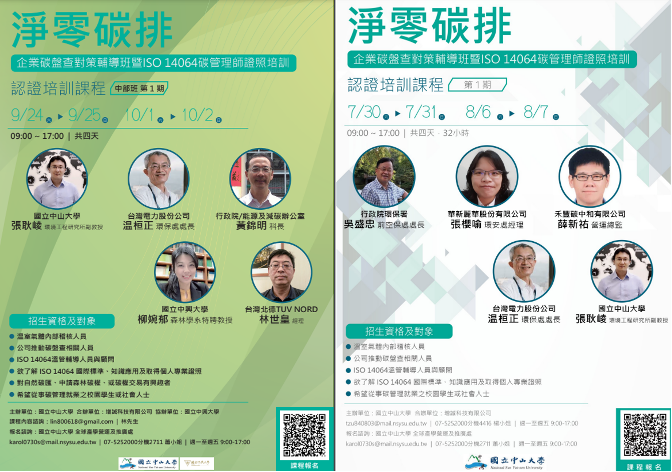
The CO2 reduction reaction involves multiple electron transfer (ET) and proton transfer (PT) processes. Therefore, understanding the reaction mechanism allows manipulation of ET and PT to achieve the desired efficiency and selectivity for a given reaction to obtain the target product.
Therefore, Professor Vincent Wang's team combined various spectroscopic methods (Time-resolved spectroscopy (time-resolved spectroscopy), infrared-visible spectroscopy, ultraviolet-visible spectroscopy), electrochemical methods and kinetic modeling to explore the multi-electron, multi-step electrocatalytic mechanism.
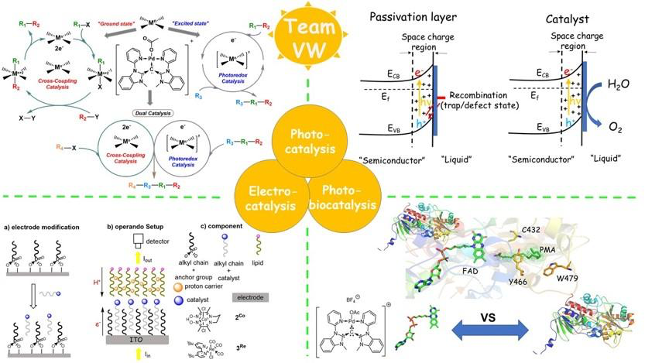
Reference:
- V. C.-C. Wang* Beyond the Active Site: Mechanistic Investigations of the Role of the Secondary Coordination Sphere and Beyond in Multi-electron Electrocatalytic Reactions. ACS Catal. 2021, 11, 8292–8303.
- V. C.-C. Wang*; B. A. Johnson Interpreting the Electrocatalytic Voltammetry of Homogeneous Catalysts by the Foot of the Wave Analysis and its Wider Implications. ACS Catal. 2019, 9,7109-7123.
- Y.-C. Hsu; V. C.-C. Wang*; K.-C. Au-Yeung; C.-Y. Tsai; C.C. Chang; B.C. Lin; Y.-T Chan; C.-P .Hsu; G.P.A. Yap; T. Jurca*; T.-G. Ong* One-Pot Tandem Photoredox and Cross-Coupling Catalysis with a Single Palladium Carbodicarbene Complex. Angew. Chem. Int. Ed. 2018, 57, 4622-4626.

